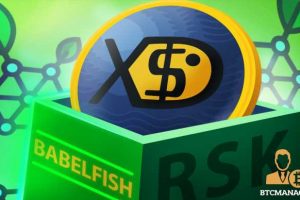Cross-Chain Stablecoin Babelfish Adds RDOC to RSK's Stablecoin Protocol

RSK is proud to add the Babelfish stablecoin to its stablecoin protocol. RSK users will now enjoy the support of RDOC aside from the cross-chain digital asset. Babelfish facilitates the exchange and the flow of stablecoins to achieve a decentralized financial system. They also help to improve the use of crypto dollars in different protocols.
RSK Looks Forward to New Beginnings
The RDOC stablecoin has advanced rapidly on RSK in terms of adoption. It collects liquidity from several chains and issuers. Within two months of being live on mainnet, XUSD meta-stablecoin has hit 10 million in deposits. This acceptance and growth of XUSD signifies that users are ready to experiment with the growing space of DeFi on Bitcoin.
There will be more users porting their stablecoins to RSK. XUSD stablecoin is easy to distribute and assemble, making it the most liquid stablecoin on the RSK platform. Sovryn can be credited for the initial growth of Babelfish.
For the uninitiated, Sovryn is a platform where new projects can grow and raise funds to build a financial ecosystem around Bitcoin. The aforementioned DeFi project, launched early this year on Babelfish, integrated XUSD to its bridge and frontend.
The integration helped to provide USD liquidity and simplify UI/UX. Moreover, it enabled the addition of the FISH token and XUSD to the Defiant Wallet and Liquality cryptocurrency wallets. The Babelfish’s FISH token is available on Sovryn’s exchange for a purchase.
Innovation At Its Best
The spokesman of Babelfish said:
“We want to thank the Sovryn community for embracing the XUSD proof of concept early on, and for helping Babelfish successfully launch FISH as the first project in the Origins launchpad. This is the beginning of a long journey, and through DAO, everyone will be able to participate in shaping the direction of the protocol to enhance multi-chain stablecoin flow and contribute to Bitcoin’s adoption.”
The objective of Babelfish’s DAO is to facilitate the flow of stablecoin across different chains and ensure there is minimal risk. It also aims to reward the competition, development, and research of stablecoins.
Babelfish protocol already accepts major stablecoins from Binance, Ethereum and RSK. Two players dominate 85% of the total float of USD-stablecoin. The Babelfish’s DAO aims to enable a thousand stablecoins to grow and interact with each other to bring mass adoption rather than relying on the two issuers.
The Mission of Babelfish
The combined USD liquidity of the growing markets of stablecoin and DeFi is fractured. Hence, Babelfish provides a simpler interface and deeper liquidity by assembling these fractured liquidity swamps to create a liquidity lake.
Babelfish is decentralized, and users can vote in the direction of the protocol. This protocol is like a dBank that enables the exchange of stablecoin 1:1 across chains and survives distortions in the market. If a user intends to use their stablecoin on another chain, they can put it in Babelfish and obtain a convertible stablecoin on the other chain.
Related posts:
Source: Read Full Article
